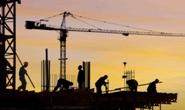Steel Markets

Construction Firms Add 11,000 Employees in October
Written by Sandy Williams
November 5, 2016
Construction demand in the private sector is driving increases in construction employment and offsetting declines in public sector jobs, said the Associated General Contractors of America in their November press release. Residential construction employment grew 5.4 percent year-over-year in October while nonresidential construction jobs grew 1.4 percent. AGC notes that public construction needs the support of local, state and federal officials to build and repair aging infrastructure. Heavy and civil engineering employment in the public construction sector declined by 1,200 jobs in the past year. The latest report by AGC follows:
![]() AGC, Nov. 4, 2016 – Construction employers added 11,000 jobs in October as employment in the sector is at the highest level since December 2008 despite declines in public sector investments in construction projects, according to an analysis by the Associated General Contractors of America. Association officials noted that average hourly earnings for construction workers increased by 3.2 percent compared to 12 months ago as firms continue to expand amid shortages of available qualified workers.
AGC, Nov. 4, 2016 – Construction employers added 11,000 jobs in October as employment in the sector is at the highest level since December 2008 despite declines in public sector investments in construction projects, according to an analysis by the Associated General Contractors of America. Association officials noted that average hourly earnings for construction workers increased by 3.2 percent compared to 12 months ago as firms continue to expand amid shortages of available qualified workers.
“There is a two-part story in construction right now as private-sector demand continues to boost employment while declining public-sector demand is contributing to year-over-year declines in heavy and civil engineering construction,” said Ken Simonson, the association’s chief economist. “Overall construction employment would certainly be higher if local, state and federal officials were investing more to build new and repair aging infrastructure.”
Construction employment totaled 6,679,000 in October, an increase of 11,000 from September and 195,000 or 3.0 percent from a year ago. The annual rate of increase in construction employment was nearly twice as fast as the 1.7 percent increase for total nonfarm payroll employment. There were 512,000 unemployed jobseekers in October who last worked in the construction industry, the lowest total for October in 10 years, Simonson added.
Residential construction—comprising residential building and specialty trade contractors—added 4,500 jobs in October and 139,700, or 5.6 percent, compared to a year ago. Nonresidential construction—building, specialty trades, and heavy and civil engineering construction firms—added 6,700 jobs for the month and gained 55,000 employees compared to October 2015, a 1.4 percent rise. Construction employment is up year-over-year for all segments except heavy and civil engineering construction, which lost 1,200 jobs since October 2015 amid declining public-sector investments in construction.
As the available supply of workers continues to shrink, average hourly earnings, a measure of wages and salaries for all workers, increased 3.2 percent in construction over the past year to $28.39 in October, nearly 10 percent more than for all nonfarm jobs, the economist noted. For the private nonfarm sector, earnings rose 2.8 percent over the past 12 months to $25.92.
Association officials noted that private-sector demand for construction is more than offsetting declines in public-sector investments in infrastructure and other public works projects. They added however, that heavy and civil engineering firms likely have the capacity to meet any growth in public-sector demand. They urged Congress to pass a new water resources bill to finance upgrades to waterways and find permanent funding solutions for highway, transit and clean water improvements.
“Even as many firms benefit from strong private-sector construction demand, firms that perform public-sector work continue to struggle with low demand,” said Stephen E. Sandherr, the association’s chief executive officer. “The one silver lining in this is that these firms have the capacity to meet any future growth in public-sector infrastructure investments.”

Sandy Williams
Read more from Sandy WilliamsLatest in Steel Markets

CRU: Sheet import demand softens as domestic price gains have slowed
US domestic sheet price gains have begun to slow as previously pulled-forward demand has led to a decline in orders.

CMC looks beyond Arizona micro-mill woes to long-term viability of construction mart
Despite the economic and geopolitical upheaval of the last five years, CMC President and CEO Peter Matt points out that the construction market has been an essential element of the way forward.

US importers face stricter rules under revamped S232 tariffs
“CBP expects full compliance from the trade community for accurate reporting and payment of the additional duties. CBP will take enforcement action on non-compliance," the agency said in a March 7 bulletin.

Steel exports rebound in January
US steel exports recovered to a five-month high in January after having fallen to a two-year low in December. This growth follows four consecutive months of declining exports.

Construction spending drops marginally in January
Construction spending edged down slightly in January, slipping for the first time in four months. The US Census Bureau estimated spending at a seasonally adjusted annual rate of $2,196 billion in January, down 0.2% from December’s downward revised rate. The January figure is 3.3% higher than a year ago. January’s result, despite the slight erosion, […]
